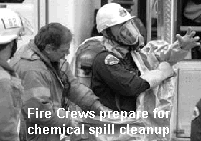Scenario

A chemical spill at Sarnia Southern High
School disrupted traffic and class schedules Monday as Sarnia Fire
Department fire-fighters cleaned the contaminated area. A four-litre
container of an unknown solid crystalline substance broke open after being
placed on a lab table. The chemical was being used by two students in the
science wing of the school, according to Lt. Bond, spokesperson for the
Fire Department. The accident occurred at about 10:30 a.m. The students in
the lab left the room, closed the door behind them and called the
authorities after the accident. The building was then
evacuated. Bond said there were no injuries and that it was
fortunate that no one was hurt. "The folks here knew what they were
doing," said Cova Lent, a FD battalion chief. "They did a good
job."
As a fire department employee, you are
accountable to the public for documenting the materials you used, the
procedures you designed and the observations that you noted. This is
important because an investigation of the incident will likely follow the
clean up.
Part A: Research
Use the background material found on the first page of this issue and your text references to prepare for this task.
Part B: Testing and Inquiry
You were the chemical spill specialist at
the local fire department. You were aware that the types of agents that
you use to clean up a spill depend on the type of chemical that was spilt.
You carefully collected a small sample of
the solid in a test tube and brought it back to your lab in order to
determine how to proceed further with the clean up. The first step you
took was to determine the type of bonding in the crystalline solid by
performing at least three tests.
By figuring the bonding type you could then safely choose the
agents/materials that were necessary to clean up the chemical from the
science lab.
The tests that you perform are the
following:
Solubility:
Chemical compounds have a wide range of solubilities in various solvents.
Adding a small amount of solid sample to a small amount of solvent in a
test tube and stirring can test the solid's solubility. If solid remains
then we would say the substance is insoluble or only slightly soluble in
that solvent. You will test the solubility of the compound in water,
alcohol, and oil. Keep in mind which solvent is the most polar and which
is non-polar.)
Effect of Heat:
Place a small amount of the unknown solid on a crucible lid and heat with
the flame of a Bunsen burner. Compounds that do not decompose and have a
high melting point (e.g., KCl or NaCl) will be unchanged in the flame.
Test(s) of your own design and choice:
Research at least one other test that would help you determine the bonding
type in the solid.
Part C: Analyze and Reflect
You need to justify your decisions with data. Your
platoon chief required a formal lab report with detailed observations
recorded in a table and an explanation of your observations in terms of
what type of bonding was present in the spilt solid.
Part D: Communicate
Your final task, as spills specialist, is to draw up a
written conclusion about what you have learned about your solid and
discuss what additional tests could have been performed if equipment was
available and what results you would expect for your solid.
href="http://www.adobe.com/products/acrobat/readstep.html">![]()